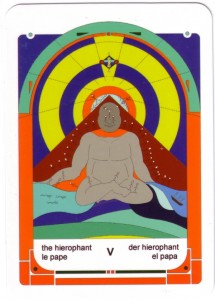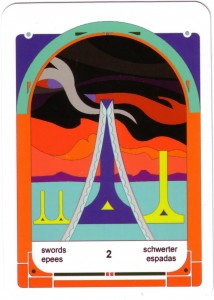Tarot in the Land of Mystereum
Posted by: WizzyWizzard on: March 5, 2012
- In: Deck Reviews | Featured
- Comment!
As a fan of more traditional and “magical” style Tarot decks such as the Waite-Smith and Thoth deck, this particular deck, Tarot in the Land of Mystereum by Jordan Hoggard (Schiffer Books, 2011) is a bit of a deviation for me.
This deck and book boxset is very well presented in an attractive, long cigar-type box. The lid of the box is held closed with magnets and opens upwards to rest on ribbon hinges which is a nice touch.
The side of the box describes it as:
A wonderful and evocative imagination primer for the young at heart!
Takes your imagination to new heights and depths.
An upbeat expression of Tarot to develop your ideas and imagination.
So let us see if it indeed lives up to those lofty claims.
On opening the box my first impression is that the cards are quite large, 9cm by 12cm. They are made from good quality laminated card stock, but unless you have quite large hands you may struggle shuffling this deck, as I did.
The deck contains 78 cards divided in the usual way, 22 Majors, 16 Court Cards and 40 Pip cards. Each card has the name of the card in English, French, Spanish and German.
All of the cards are illustrated in a very bright and vivid color scheme and they all contain the same archway style border, which actually takes up quite a lot of the card itself.
The pictures are drawn in a cartoon style using a limited color palette, giving all the cards a similar yet different look to each other; it reminds me somewhat of the Liber T deck.
The images on the Major Arcana are non-traditional, yet very imaginative, abstract and somewhat psychedelic. Each picture contains lots of details, pictures within pictures, symbols and characters. This – along with the vivid color scheme – can make you feel like you have already stepped through the looking glass.
For example, The Hierophant resembles a grey Buddha-type character sitting in a green landscape. He is in front of a large pyramid behind which is a blue and yellow sun mandala. In another card, the body of the Hierophant himself has lots of tiny stickmen walking all over him. Three other stickmen float alongside in a rowing boat … non-traditional, slightly bizarre, yet appealing to the eye.
The Justice card has some traditional imagery yet with a difference. There is a sword in the centre of the card forming the main structure of the scales, two disembodied hands rest under the scales on which a heart is being weighed against a feather.
Two other Major Arcana Cards that stand out immediately are The Hermit and Death as they have a strange connection in this deck.
The Hermit contains some familiar elements, a cloaked figure with a staff and a lantern. There is an image of the moon on one side of the card with the sun on the other. The Hermit seems to have some kind of x-ray vision beaming from his eyes and his cloak – far from being the usual grey – is a bright vibrant red!
The Death card shows a white silhouetted figure riding a white horse, as you may expect, but this particular Death carries a double ended scythe, and within each blade (top and bottom) is the image of the Hermit card, the scythe blade becoming the arched border from the Hermit card, with his cloak blending seamlessly onto the horse. This gives a strange yet pleasing imagery.
The Minor Arcana continue in the style of the Majors yet are maybe slightly less abstract, there are indications of meanings on some of the cards – the 10 of Cups shows an image of two hands held together and a picture of a family house, other Minor cards have minimal symbolism, for example a lot of the Sword cards have the same image with just a differing number of swords in the foreground .
The Court Cards each contain the image of a person as expected yet some of them contain other images from the Major Arcana; The Page of Cups has the image of The Hanged Man while the Page of Pentacles has images of the Magician, the Hierophant and the Chariot hidden within.
Does infinity have a middle?
Is infinity in each of us?
Is infinity in both each of us and all of us?
These are some of the questions given for you to ponder in the introduction to the book. The book is written in a light-hearted, almost childish style at times. The learning method within is, according to the box, “a character driven approach giving each tarot card a personality linked to youâ€.
Instead of having a list of keywords to learn, this book encourages you to make a personal connection with each card. Each card is introduced one at a time starting with the Fool and working through all the Majors and then the Minors in order. You are encouraged to look at the cards and “breathe” them before reading the chapter for each individual card.
There is a brief description of what the card indicates and a black and white picture of the card. Then there is a statement from each card character itself – you are encouraged to read these out loud, also each card has a “gift†for you to encourage your imagination and creativity.
For the Devil we have statements such as:
The Devil in one way indicates the power of your expectations with focus rather than blind spots. The Devil is not “Satan”. The Devil here is Pan. He is half goat, nature god. Some call him Dionysus. Others call him Bacchus. Pleasure, and to happily let go in the wild, unbridled play is indicated.
After this initial description you are met by the card character himself, each one having his or her own distinct personality. The Devil introduces himself like this:
Huuuuurrrrroooo!!!!! How RRRRR UUUUU? I am not THAT devil. I am not Satan. I am a deity more like Pan. I will hang back a little and let that settle in for you. Proceed when you feel ready.
As for the “giftsâ€, The Fool has three gifts; the first being “feel and remember natural and new directions you create as you move and evolve your ideas with imagination and creativity” .
This seems to be an effective way to get you actually thinking and using your own ideas to evoke meanings from the cards and I really like this approach. It gives you a real feeling for the card so much more than just listing possible meanings and keywords. It creates an image in your mind and enables you to make a more personal connection with the card as a living entity rather than just a printed picture.
Having expected to not like this deck I find that the more time I spend with it the more I am drawn into both the imagery and the learning method. It is a great intuitive deck with very colorful artwork. There is a lot of movement within the pictures so you feel like you could just step into some of the strange scenes. The Majors are particularly attractive and evocative.
This is a great deck for beginners with no previous knowledge of Tarot meanings clogging up their brains, yet it is also a good tool for more intermediate or professional readers who want to get back to feeling the cards more rather than working from keywords or past learning.
This would perhaps also be an ideal deck to introduce children to the subject.
I will continue to work with this deck and the accompanying book. My only criticism is the size of the deck itself; it might be a struggle in actual readings. For study and meditation on the cards I think it has great potential.
You can buy the deck at Amazon and the main site for the deck is Jordan Hoggard: Tarot in the Land of Mystereum.
Wizzy Wizzard
Search
- Veronique Coppin: could you please send me the link to download the companion book with extra information on the gilded reverie lenormand cards? It's no longer availab
- Conversation with Karen Lisa Salamon – Eng Agger · MA Fine Art Digital: […] card which he used to start his imagination. Dali read the cards; he saw signs. It is to find in “Tarot Universal Dali”. Seeing
- Deck Overview: The Steampunk Tarot – Deanna Discusses: […] Blog reviews: Aeclectic Tarot, New Paths Tarot, Perspectives on Tarot, Tarot Elements, and The Tarot Review […]
Categories
- Announcements (3)
- Book Reviews (1)
- Deck Reviews (18)
- Featured (22)
- Golden Oldies (3)
- Latest Decks (10)
- Sneak Peaks (6)


